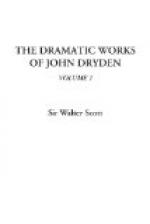The king appears to have been hardly less anxious to promote the dispersion of “The Hind I and the Panther,” than the Protestant party to ridicule the piece and its author. It was printed about the same time at London and in Edinburgh, where a printing-press was maintained in Holyrood House, for the dispersion of tracts favouring the Catholic religion. The poem went rapidly through two or three editions; a circumstance rather to be imputed to the celebrity of the author, and to the anxiety which foes, as well as friends, entertained to learn his sentiments, than to any disposition to acquiesce in his arguments.
But Dryden’s efforts in favour of the Catholic cause were not limited to this controversial poem. He is said to have been at first employed by the court, in translating Varillas’s “History of Heresies,” a work held in considerable estimation by the Catholic divines. Accordingly, an entry to that purpose was made by Tonson in the Stationers’ books, of such a translation made by Dryden at his Majesty’s command. This circumstance is also mentioned by Burnet, who adds, in very coarse and abusive terms, that the success of his own remarks having destroyed the character of Varillas as an historian, the disappointed translator revenged himself by the severe character of the Buzzard, under which the future Bishop of Sarum is depicted in “The Hind and the Panther."[14] The credulity of Burnet, especially where his vanity was concerned was unbounded; and there seems room to trace Dryden’s attack upon him, rather to some real or supposed concern in the controversy about the Duchess of York’s papers, so often alluded to in the poem, than to the commentary on Varillas, which is not once mentioned. Yet it seems certain that Dryden entertained thoughts of translating “The History of Heresies;” and, for whatever reason, laid the task aside. He soon after was engaged in a task, of a kind as unpromising as remote from his poetical studies, and connected, in the same close degree, with the religious views of the unfortunate James II. This was no other than the translation of “The Life of St. Francis Xavier,” one of the last adopted saints of the Catholic Church, at least whose merits and supposed miracles were those of a missionary. Xavier is perhaps among the latest also, whose renown for sanctity, and the powers attending it, appears to have been extensive even while he was yet alive.[15] Above all, he was of the order of Jesuits, and the very saint to whom Mary of Este had addressed her vows, in hopes to secure a Catholic successor to the throne of England.[16] It was, therefore, natural enough, that Dryden should have employed himself in translating the life of a saint, whose virtues must at that time have appeared so peculiarly meritorious; whose praises were so acceptable to his patroness; and whose miracles were wrought for the credit of the Catholic Church, within so late a period, besides, the work had been composed by Bartoli, in Portuguese;




